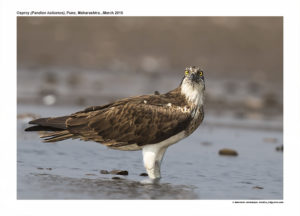Osprey

Osprey Pandion haliaetus
Etymology:
- Pandion :Greek mythology ,king of Athens named Pandion ,son of Cecrops II and father of Nisus. Nisus later transformed into hawk
- Haliaeetus : Latin word hali– sea; aetoseagle { Sea eagle}
Vernacular Names: Hindi: ChotaMachhlimaar, Machhmanga, Machhariya, Sans: Matsyakurr, Pun: Machhimaar, Ben: Machhmarol, Kurari, Utkrosh, Lepcha: Pantiong, Nepal: Machharang, Guj: Machhimaar, Matsyabhoj, Mar: Kaiikar, Ta: Vraaladdipan, Te: Koramengadda, Yerkali: Heggiuli, Mal: Talipparundu
Distribution in India:
Widespread winter visitor in India.
Description: Size of 55-58 cm.It has a dark stripe through eye; speckled brown necklace, variable in intensity depending on race and sex, generally less marked in males. Distinctive pattern in flight, all white below with blackish-brown carpal patches and greater underwing-coverts; wing bends back at carpal joint, giving characteristic shallow V-shape. Wings relatively long and narrow. Immature is similar to adult but paler brown above, with feathers edged buff; breastband less marked.Female is larger than the male.
Habitat: It is found in shallow waters, fresh, brackish and marine. Nests along lake shores, seashores, marshes and rivers; also on deadwood swamps and reservoirs. Highest densities generally near salt water, especially salt marshes, mangrove swamps, coastal lagoons and bays. Favors islands for nesting, thereby gaining protection from predators. Becomes accustomed to human activity, so tolerates suburban, even urban habitats. Feeds in rivers, bays, marshes, reservoirs, lakes and ponds, wherever fish are available near water surface.
Food Habits: It’s a specialist Piscivore .It eats mainly fish. Ospreys have vision that is well adapted to detecting underwater objects from the air. Prey is first sighted when the osprey is 10–40 m above the water, after which the bird hovers momentarily then plunges feet first into the water. Occasionally, the osprey may prey on rodents, rabbits, hares, amphibians, other birds and small reptiles. The osprey has several adaptations that suit its Piscivorous lifestyle like reversible outer toes,sharp spicules on the underside of the toes,closable nostrils to keep out water during dives ,backwards-facing scales on the talons which act as barbs to help hold its catch, dense plumage which is oily and prevents its feathers from getting waterlogged.
Breeding Habits: They breed from Jul–Nov in North Australia and Aug–Feb in South Australia, Sept- Dec in Cape Verde and Red sea region. The nest is a large collection of sticks and flotsam even including bones, lined with grasses and moss where available, usually wedged high in an exposed tree; will nest also on cliff or on power pole, disused building, buoy, or specially designed platform, also on ground on predator-free islands, always with clear all-round visibility. Nest frequently reused in subsequent seasons; exceptionally favored sites may be reused. They lay a clutch of 1–4 eggs. Replacement clutch may be laid within 2–3 weeks if first eggs are lost .The incubation period is 34–43 days, commencing with first egg and by both sexes; chicks hatch altricial , sequentially, 1–7 days apart .The youngest chick is disadvantaged when food scarce, but Siblicide occurs even in areas of high food abundance. Chick are fed by female, provisioned by male. The fledging period is 44–59 days and young are independent 30–60 days later.